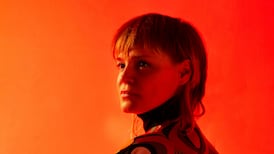TRAVELLING LIGHT: Hamish Fulton's show at Tate Britain is a profound and touching record of 30 years on the move, writes Aidan Dunne
In 1971, Hamish Fulton decided he would go for a walk and, with just the occasional break, he's been walking ever since. Fulton is an artist and the walks he plans, executes and records with ritualistic care form the substance of his art.
He is, as he says, "a walking artist". What we see in his exhibitions, including Tate Britain's current show, walking journey, which concentrates on the last 10 years' work but extends back over 30 years, are the fine photographs, mostly in black and white, that he takes along the way, often accompanied by terse, enigmatic captions, beautiful books made up of photographs and text, and big coloured graphics inspired by each excursion.
These activities emerge from a volatile moment in modern art history in the late 1960s, when the conventions of form, material, galleries and the art market were momentarily overthrown in a heady rush to the frontiers of conceptualism, land art and myriad other alternatives. While there have certainly been developments in his work, Fulton has remained resolutely true to the simplicity of his original approach, which is, essentially, walking. There are echoes of retreat and pilgrimage in his spartan, mostly solitary treks across vast, usually empty landscapes.
He was obviously aware of that from the start, because one early project was called The Pilgrims' Way and involved following the ancient pilgrim paths between Shrewsbury and Canterbury. He subsequently followed other pilgrimage routes, in England, Japan and Spain. But he points out that he walks as an artist, not as a Christian. In the Pyrenees last year he walked the Santiago del Compostela route in the "wrong" direction ("At least 500 people said 'wrong way' as I passed").
He has been several times to Mount Hiei in Japan, where the Marathon Monks meditate by circling the mountain 1,000 times in 1,000 days, a distance equivalent to walking around the world. The monks, he says, opened him to the possibility of repeat walks. His own walks vary in duration from hours to weeks. Visits to Ireland include a walk from Donegal to Cork.
Fulton was born in London in 1946 and grew up in Newcastle, going on to study at St Martin's College of Art in London. He recalls, aged seven, climbing to the highest point of the Scottish island of Arran and, as the wind blew and the mist cleared, feeling released from the cares of the world. His interest in the American Plains Indians prompted him to visit the US and he acknowledges that his view of their traditional way of life, close to nature, influenced his artistic development.
Until May 14th, his show is appropriately partnered at Tate Britain by American Sublime, a survey of 19th-century landscape painting in the United States. For this visitor at least, his work is a welcome contrast to the straining theatricality of endless evocations of "the Sublime". By comparison with their showy determination to impress, Fulton's patient, humble, unsentimental, positively mundane encounters with the elements are in the end more profound and touching.
His work cannot help but be ecologically aware. He doesn't proselytise for the environmental cause, but it is interesting that, for his catalogue (a beautiful publication), he invited contributions from two individuals outside the art world. One is Bill McKibben, whose book, The End of Nature, warned of the effects of global warming; the other is Doug Scott, a mountaineer who pioneered the move towards lightly-equipped, Alpine-style climbing in the Himalayas rather than huge siege expeditions.
BESIDES his evident talents for walking and taking good photographs, Fulton could clearly have a fruitful sideline as a typographic designer. His use of typography arose because he wanted to make it clear he wasn't making images in the conventional sense. He wasn't just an artist who went on walks, during which he found nice images. While his innate aesthetic sense governs the composition of his photographs, snippets of factual texts superimposed on or adjacent to them refer us to the immediacy of the walk. The walk is the work; images in the gallery are a record, a residue.
It is reasonable to associate him with the romantic tradition of British landscape art, from Turner and Constable to contemporary sculptors like Richard Long (whom he has accompanied on several walks) and Andy Goldsworthy, both of whom enact their work within the landscape. The vital difference is that while they either make something in the landscape or remake the landscape itself, or place material from it in a gallery, Fulton's aim is to travel light and "leave no trace". The most idiosyncratic aspect of his output is made up of what are, effectively, billboard-sized typographic murals, made by applying cut vinyl lettering to painted walls or large-scale photographic prints. Fulton designs them and has them installed by professionals. They look terrific, but the effect is strange.
They take the language of advertising, but are not trying to sell us anything. Or perhaps they are. As Fulton sees it: "Imagine advertising clouds! And you can't get any better than clouds . . . I use commercial graphics as a decoy for the subject-matter."






